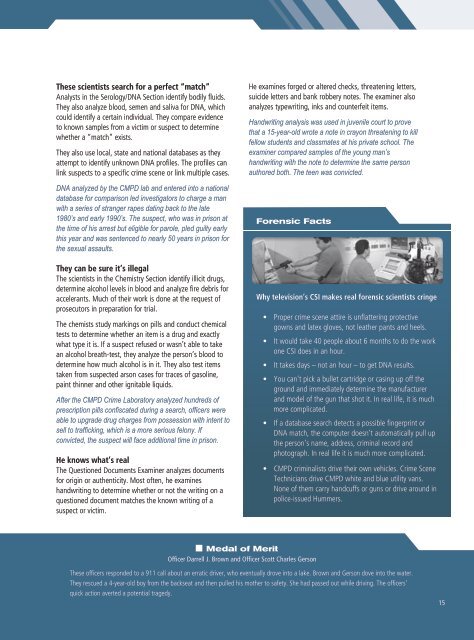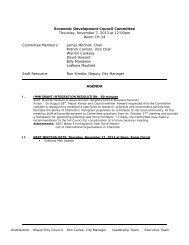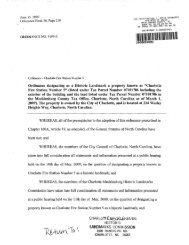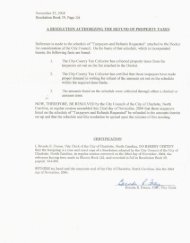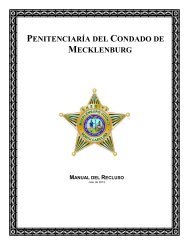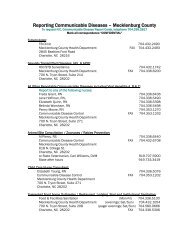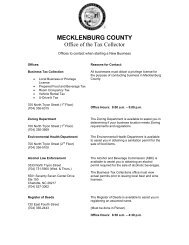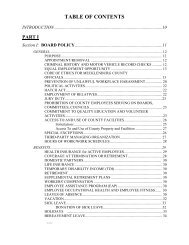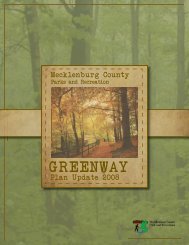Annual Report for 2007 - Charlotte-Mecklenburg County
Annual Report for 2007 - Charlotte-Mecklenburg County
Annual Report for 2007 - Charlotte-Mecklenburg County
- TAGS
- annual
- charmeck.org
You also want an ePaper? Increase the reach of your titles
YUMPU automatically turns print PDFs into web optimized ePapers that Google loves.
These scientists search <strong>for</strong> a perfect “match”<br />
Analysts in the Serology/DNA Section identify bodily fluids.<br />
They also analyze blood, semen and saliva <strong>for</strong> DNA, which<br />
could identify a certain individual. They compare evidence<br />
to known samples from a victim or suspect to determine<br />
whether a “match” exists.<br />
They also use local, state and national databases as they<br />
attempt to identify unknown DNA profiles. The profiles can<br />
link suspects to a specific crime scene or link multiple cases.<br />
DNA analyzed by the CMPD lab and entered into a national<br />
database <strong>for</strong> comparison led investigators to charge a man<br />
with a series of stranger rapes dating back to the late<br />
1980’s and early 1990’s. The suspect, who was in prison at<br />
the time of his arrest but eligible <strong>for</strong> parole, pled guilty early<br />
this year and was sentenced to nearly 50 years in prison <strong>for</strong><br />
the sexual assaults.<br />
They can be sure it’s illegal<br />
The scientists in the Chemistry Section identify illicit drugs,<br />
determine alcohol levels in blood and analyze fire debris <strong>for</strong><br />
accelerants. Much of their work is done at the request of<br />
prosecutors in preparation <strong>for</strong> trial.<br />
The chemists study markings on pills and conduct chemical<br />
tests to determine whether an item is a drug and exactly<br />
what type it is. If a suspect refused or wasn’t able to take<br />
an alcohol breath-test, they analyze the person’s blood to<br />
determine how much alcohol is in it. They also test items<br />
taken from suspected arson cases <strong>for</strong> traces of gasoline,<br />
paint thinner and other ignitable liquids.<br />
After the CMPD Crime Laboratory analyzed hundreds of<br />
prescription pills confiscated during a search, officers were<br />
able to upgrade drug charges from possession with intent to<br />
sell to trafficking, which is a more serious felony. If<br />
convicted, the suspect will face additional time in prison.<br />
He knows what’s real<br />
The Questioned Documents Examiner analyzes documents<br />
<strong>for</strong> origin or authenticity. Most often, he examines<br />
handwriting to determine whether or not the writing on a<br />
questioned document matches the known writing of a<br />
suspect or victim.<br />
Forensic Facts<br />
Medal of Merit<br />
Officer Darrell J. Brown and Officer Scott Charles Gerson<br />
He examines <strong>for</strong>ged or altered checks, threatening letters,<br />
suicide letters and bank robbery notes. The examiner also<br />
analyzes typewriting, inks and counterfeit items.<br />
Handwriting analysis was used in juvenile court to prove<br />
that a 15-year-old wrote a note in crayon threatening to kill<br />
fellow students and classmates at his private school. The<br />
examiner compared samples of the young man’s<br />
handwriting with the note to determine the same person<br />
authored both. The teen was convicted.<br />
Why television’s CSI makes real <strong>for</strong>ensic scientists cringe<br />
• Proper crime scene attire is unflattering protective<br />
gowns and latex gloves, not leather pants and heels.<br />
• It would take 40 people about 6 months to do the work<br />
one CSI does in an hour.<br />
• It takes days – not an hour – to get DNA results.<br />
• You can’t pick a bullet cartridge or casing up off the<br />
ground and immediately determine the manufacturer<br />
and model of the gun that shot it. In real life, it is much<br />
more complicated.<br />
• If a database search detects a possible fingerprint or<br />
DNA match, the computer doesn’t automatically pull up<br />
the person’s name, address, criminal record and<br />
photograph. In real life it is much more complicated.<br />
• CMPD criminalists drive their own vehicles. Crime Scene<br />
Technicians drive CMPD white and blue utility vans.<br />
None of them carry handcuffs or guns or drive around in<br />
police-issued Hummers.<br />
These officers responded to a 911 call about an erratic driver, who eventually drove into a lake. Brown and Gerson dove into the water.<br />
They rescued a 4-year-old boy from the backseat and then pulled his mother to safety. She had passed out while driving. The officers’<br />
quick action averted a potential tragedy.<br />
15


